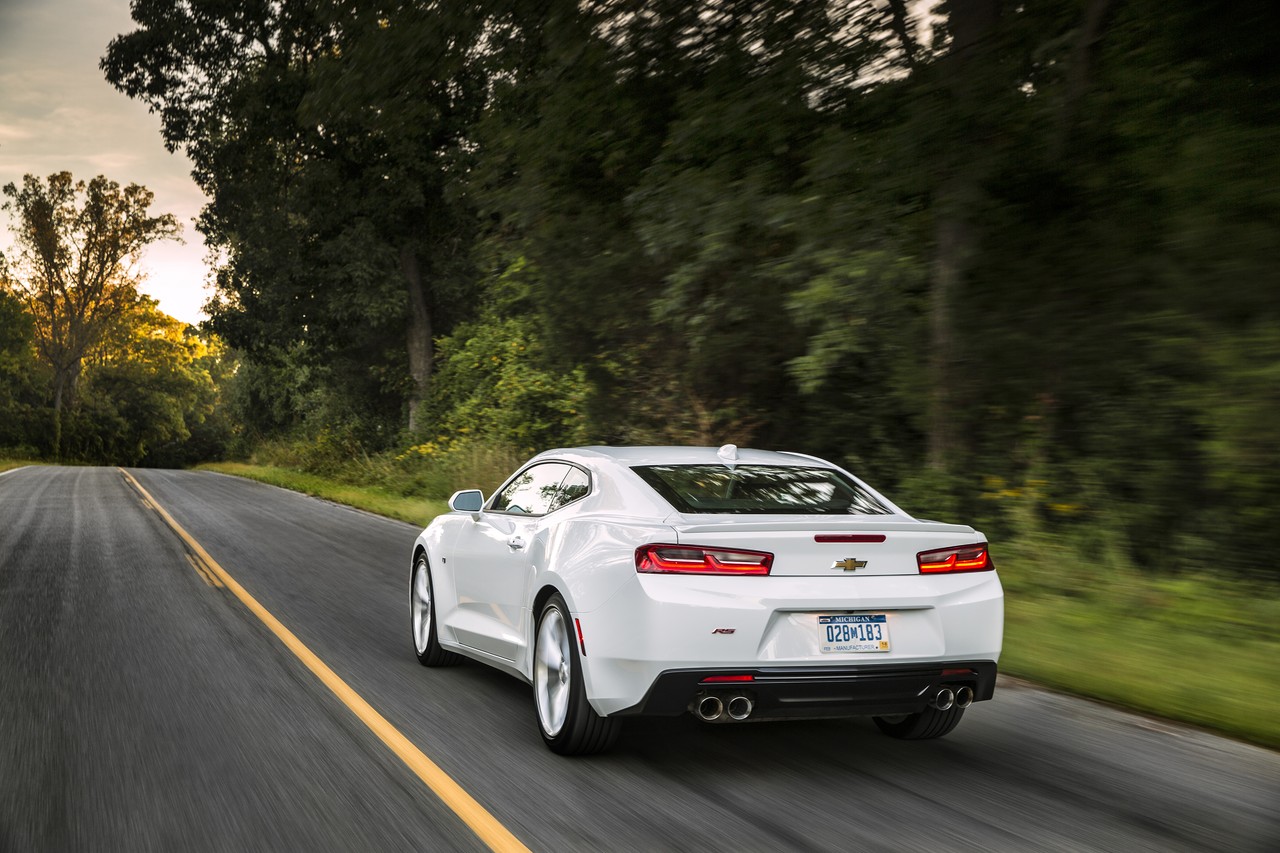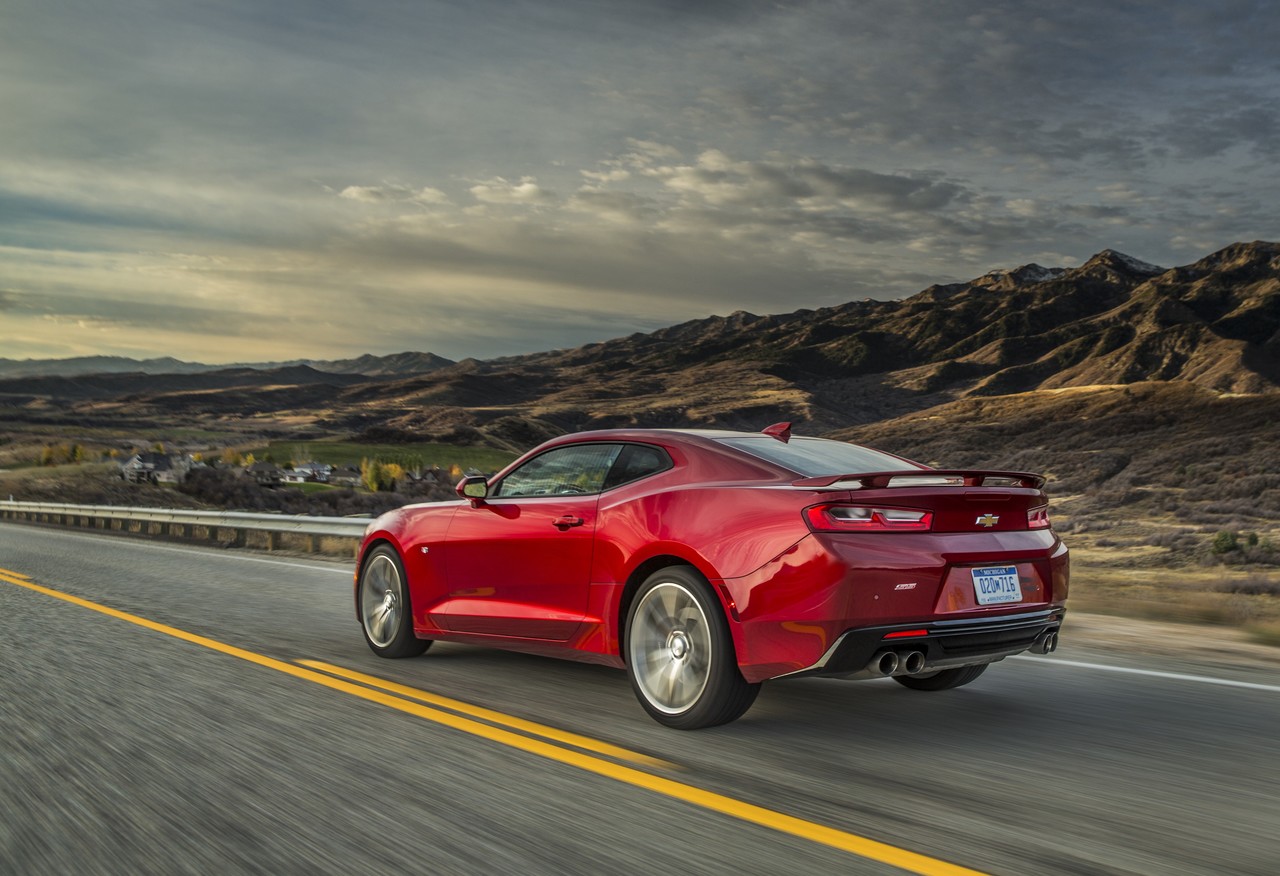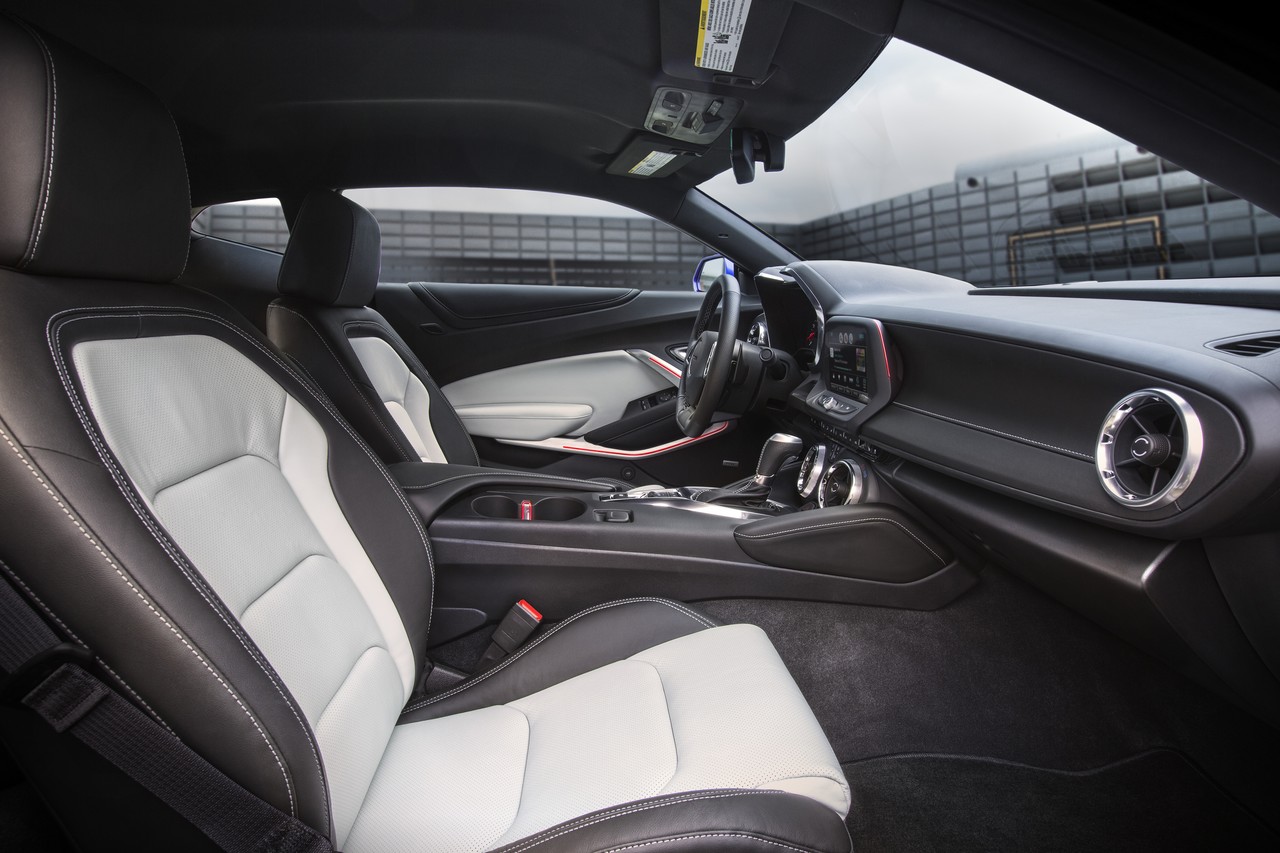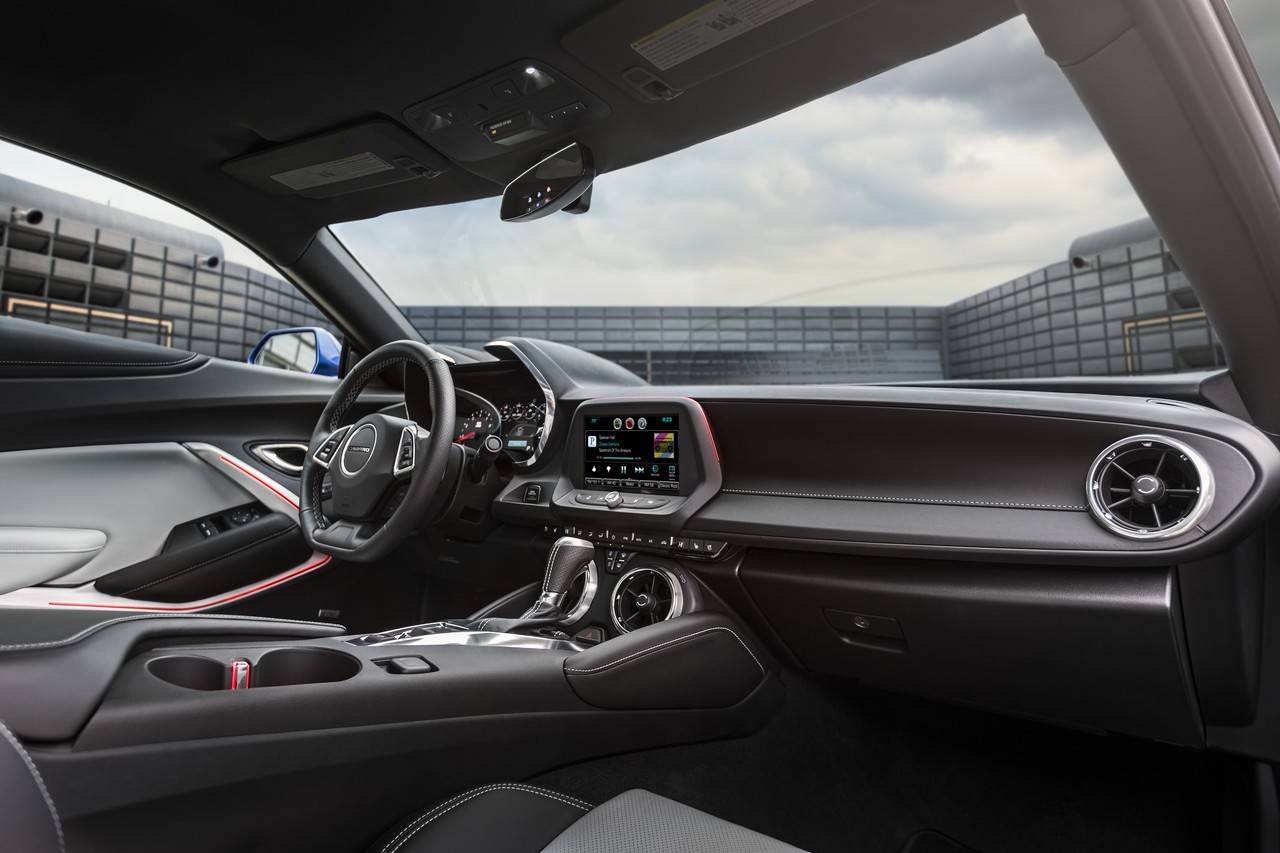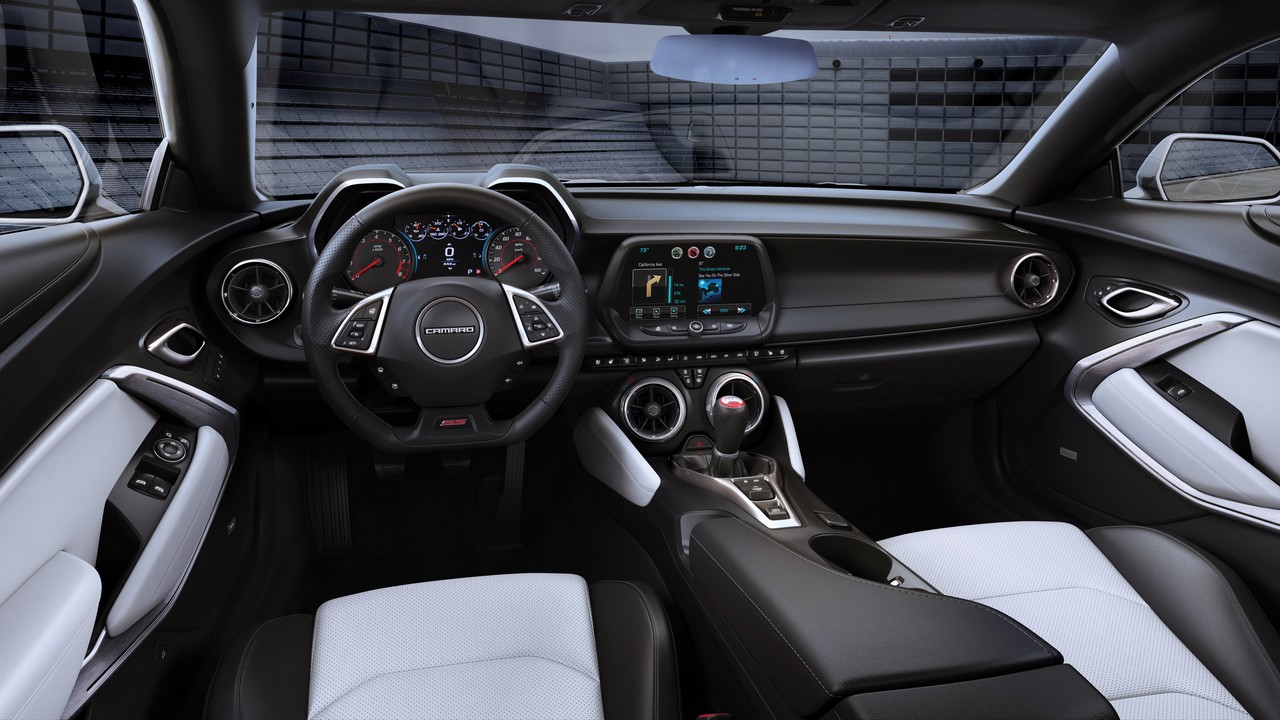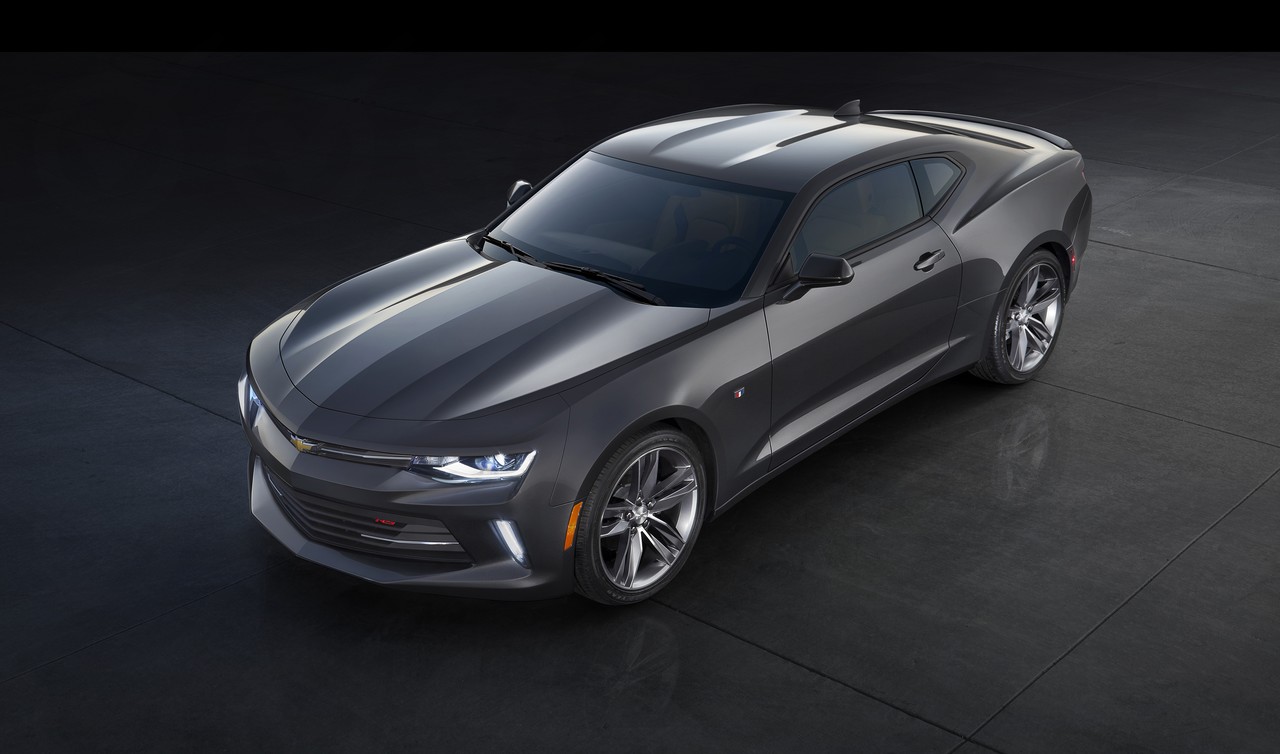
- Powerful 6.2-litre LT1 V8 engine
- Impressive dynamics
- Effective Brembo brakes
- Better engine and dynamics than the Ford S550 Mustang
- RHD conversions by HSV mean limited volume and high costs
- Autonomous Emergency Braking (AEB) not available
- Rear seats are useless
- Awful visibility
- Small boot opening
Overview
The Chevrolet Camaro 2SS Coupe was released in Australia in September 2018. Manufactured at General Motors’ Lansing Grand River plant in Michigan, United States, the Chevrolet Camaro 2SS Coupe was converted to right-hand drive by Holden Special Vehicles (HSV) at its facility in Clayton, Victoria. Conversions commenced in July 2018 ahead of the September 2018 retail launch.
The rear-wheel drive Chevrolet Camaro 2SS Coupe was powered by General Motors’ 6.2-litre LT1 V8 engine which was mated to either the six-speed manual Tremec TR6060 transmission (with an Active Rev Match function) or the eight-speed Hydra-Matic 8L90 automatic transmission. With the automatic transmission, the Camaro 2SS Coupe had a recommended retail price of $85,990 (excluding on-road costs).
‘Generation 5’ LT1 V8 engine
The LT1 V8 engine had a deep-skirt aluminium cylinder block – cast from 319-T7 aluminium – with 103.25 mm bores and a stroke of 92.0 mm for a capacity of 6162 cc. Within the block, the LT1 engine had centrifugally-cast, gray-iron cylinder bore liners. Beyond this, the LT1 engine had a forged crankshaft (produced from 1538MV steel) that was held in place by five main bearings with six M12 bolts per nodular iron main bearing cap (four vertical and two horizontal). Both the crankshaft and the sintered and forged steel connecting rods rotated on polymer-coated bi-metal eccentric bearings. The cast eutectic aluminium pistons were cooled by oil jets in the block which sprayed oil onto the undersides of the pistons.
The cylinder head for the LT1 V8 engine was cast from 319-T7 aluminium. Furthermore, the single, hollow camshaft was produced from steel billet and had induction-hardened lobes. The LT1 V8 engine had two stainless steel valves per cylinder (one intake and one exhaust, the latter sodium-filled for heat dissipation) that were actuated by cast steel, needle bearing roller rocker arms that had a 1.8:1 ratio and 8.7 mm diameter pushrods. For the LT1 engine, the 54.1 mm diameter intake valves were at a 12.5 degree angle from vertical, while the 40.4 mm diameter exhaust valves were 12 degrees from vertical. The intake and exhaust valves were also splayed (angled apart) by 2.5 degrees to increase airflow and reduce valve shrouding.
For variable valve timing, the LT1 engine had an oil-driven cam phaser that was attached to the front of the camshaft. The cam phaser had 62 crank degrees of adjustment and provided simultaneous adjustment of the intake and exhaust valves, though the intake and exhaust valves could not be varied independently of each other.
When mated to automatic transmissions, the LT1 engine had General Motors’ ‘Active Fuel Management’ (AFM) which ceased operation of valve lifters for four cylinders (cylinder 1, 7, 6 and 4) to effectively shut down those cylinders and reduce fuel consumption. AFM operated when the LT1 engine was under light loads or coasting; in contrast to the V8 firing order of 1-8-7-2-6-5-4-3, AFM provided a V4 firing order of 8-2-5-3.
The LT1 V8 engine had direction injection (General Motors’ ‘Spark Ignition Direct Injection’ or SIDI). For SIDI, the dual-pressure pump – which could achieve fuel pressures of up to 15 Mpa) – was driven off the rear of the tri-lobe camshaft and mounted between the cylinder heads (below the intake manifold). The six-hole injectors were positioned underneath the intake ports and suspended in the cylinder heads by the fuel rail to isolate injector pulses. Furthermore, the LT1 engine had a compression ratio of 11.5:1. AustralianCar.Reviews understands that the LT1 is the first overhead valve (OHV) engine to have direct injection.
| Engine | Trans. | Peak power | Peak torque | |
|---|---|---|---|---|
| Chevrolet Camaro 2SS | 6162 cc LT1 petrol V8 | 6sp man. (TR6060), 8sp auto (8L90) |
339 kW at 6000 rpm | 617 Nm at 4400 rpm |
Body and dimensions
The sixth generation Chevrolet Camaro was based on General Motors’ Alpha platform which was shared with the 2013 Cadillac ATS and 2014 Cadillac CTS. General Motors, however, claimed that 70 per cent of architectural components in the Camaro were unique. For the Alpha platform, mass reduction measures included an aluminium instrument panel frame, aluminium front suspension links and ‘lightening holes’ for the steel rear suspension links.
The Chevrolet Camaro coupe was 4784 mm long, 1897 mm wide, 1348 mm tall and has a 2811 mm long wheelbase; luggage space was 257 litres. Kerb weights for the Camaro V8 coupe ranged from 1671 kg (manual) to 1697 kg (automatic).
Suspension and Magnetic Ride Control
The Chevrolet Camaro had MacPherson strut front suspension with dual lower ball joints and twin-tube struts and a direct-acting stabiliser bar. The independent rear suspension had five links, twin-tube shock absorbers and a direct-acting stabiliser bar.
The Chevrolet Camaro SS was available with ‘Magnetic Ride Control’ which used magnetorheological monotube shock absorbers. When an electrical current was applied, iron particles in the fluid created a fibrous structure in the direction of the magnetic field to increase the viscosity of the fluid and therefore damping resistance. To determine when to apply the current, sensors were used to monitor road and driving conditions 1000 times per second.
Steering
The Chevrolet Camaro had ZF rack-and-pinion steering with electric power assistance and a variable (i.e. speed-sensitive) ratio; its turning circle was 11.6 metres.
Safety equipment
Standard safety equipment for the Chevrolet Camaro Coupe included dual front head airbags, front knee airbags, front seat-mounted side airbags, curtain head airbags, ABS, electronic brake force distribution, brake assist, electronic stability control, traction control and front seatbelts with pre-tensioners and load limiters.
Furthermore, the Chevrolet Camaro 2SS was equipped with the following technologies as standard:
- Rear Cross-Traffic Alert: when reversing, short-range radar sensors in the rear bumper could detect approaching traffic up to 20 metres away that may cross the driver’s intended path. If detected, the driver was alerted by three low-pitched tones and red flashing triangles in the rear vision camera display; and,
- Lane Change Alert with Side Blind Zone Alert: used radar sensors to detect if a vehicle was in an adjacent lane and up to 3 metres behind the driver. If detected, a symbol in the door mirror would illuminate to alert the driver. If the driver activated the turn indicator in the direction of the detected vehicle, the symbol would flash.
Wheels, tyres and brakes
The Chevrolet Camaro 2SS had 20-inch, five-spoke wheels (8.5J front and 9.5J rear) that were fitted with 245/40 ZR20 front and 275/35 ZR20 rear Goodyear Eagle tyres. Furthermore, the Camaro 2SS had 345 mm ventilated front and 339 mm ventilated rear brake discs with four-piston Brembo callipers (front and rear).
Features: Chevrolet Camaro 2SS
As standard, the Chevrolet Camaro 2SS was equipped with a ‘MyLink’ infotainment system which had an eight-inch touch screen, Bluetooth mobile phone connectivity and wireless mobile phone charging.
Beyond this, standard features for the Chevrolet Camaro 2SS included a Bose sound system with nine speakers, ventilated and heated front bucket seats, an eight-way power adjustable driver’s seat and a six-way power adjustable front passenger seat, dual-zone climate control air conditioning, cruise control, high-intensity discharge (HID) headlights, LED daytime running lamps, a rear view camera, rear parking sensors (‘Rear Park Assist’), a head-up display, a leather-wrapped steering wheel with heating function, remote central locking, power adjustable and heated door mirrors, power windows, a height and reach adjustable steering wheel, auto-dimming driver’s side and interior rear view mirrors, 24 colour interior ambient lighting, illuminated vanity mirrors and sill plates, floor mats, tyre pressure monitoring, a trip computer and an immobiliser.

